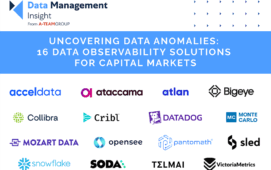This month the industry at large is focused on the possible outcome of the ongoing global regulatory overhaul, as governments in the US and Europe prepare to provide more details about their proposals for change. The Obama administration has readied its suggestions for change, which include an overhaul of the way ratings agencies are monitored and curbs on excessive risk taking among systemically important financial institutions. European ministers are similarly engaged and are also keen to ensure that there is some level of consistency across the region in terms of oversight via the introduction of European level regulatory bodies.
If nothing else, regulation has certainly proved a positive force for investment in data management in the past and it is likely that this instance will prove no exception. The issue of counterparty data has certainly been an area of focus for regulators and industry participants alike over recent months. The spectre of counterparty risk has been haunting the halls of many a financial institution since the troubles experienced by many of the major players in the market last year.
To this end, our two lead stories provide viewpoints on how to tackle the tricky area of business entity identification, given the failure of the IBEI to gain traction in the market. Regardless of whether, like Swift’s Vandenreydt, you believe a utility approach should be adopted, or, like Interactive Data’s Marsh, you believe the vendor community should retain the reins, it cannot be denied that the way entities are identified is on the cusp of great changes.
From the vendor side of the camp, Standard & Poor’s Cusip Global Services (CGS) business has been beavering away in the background with its joint project with Avox on the Cusip Avox Business Reference Entity identifier (CABRE), which we covered in last month’s issue. Moreover, this month CGS announced yet another string to its entity identification bow with the news that it will be working with yet another vendor, HedgeFund.net, to tackle the area of identification for hedge funds and funds of hedge funds.
This all plays into the concept of better risk management: one of the few areas of IT investment that remains funded in these troubled economic times. By tying data management in with initiatives to improve risk management, data managers can gain the support of senior managers and secure funding for targeted projects.
Some of the bigger players in the market are also trying to regain the confidence of the investment community by talking up the benefits of rationalisation. Citi is a case in point, with its ambitious programme to integrate its patchwork of IT systems in order to get a better handle on its data and reduce duplication of effort. Vikram Pandit, Citi’s CEO, has been championing the ideals of integration and stated his intention at the start of the year to save the firm US$1 billion in technology costs via a rationalisation of its systems.
The project at Citi is likely to touch on many aspects of data management, especially with regards to downstream systems integration, which has been another hot topic for Reference Data Review readers this month. According to the results of our latest reader poll, a lot of you are concerned about the downstream impact of data management projects. A total of 69% of respondents indicated that they believe formal working groups should be established in order to better tackle this issue.
Interoperability and integration between downstream systems and centralised data management systems is likely to recur as theme over the course of the year, as regulators clamp down on financial institutions’ risk management practices. Hopefully, some of the longstanding back office siloes will be broken down, but as with anything in such a climate, progress is likely to be slow.
Subscribe to our newsletter




